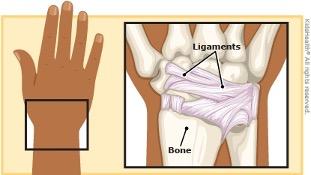Topics
Sprained Wrist: How to Care for Your Child
A wrist sprain is a common injury. While it can be quite painful, it usually heals within a few weeks.

Your Child's Diagnosis
The wrist joint is made of bones, ligaments (strong bands that hold the bones together), and tendons (bands that attach muscle to bone). A sprain is an injury to a ligament, which can happen when the wrist bends or twists too far. Children may sprain a wrist when they trip and hold their hand out to stop the fall. Kids who play sports that involve a lot of repeated wrist motions can also get sprains, especially if they take on these activities too quickly.
The health care provider asked questions about the injury and did a physical exam, touching the area to see if it there was pain or swelling. An X-ray of the wrist may have been done to check for other injuries.
A sprain can take days or weeks to heal, depending on the injury. Your child's health care provider might use an elastic bandage, brace, or splint to support the wrist while it is healing. Special exercises might be recommended.
Home Care Instructions
- For the first 48 hours, think RICE:
- Rest: Your child should not use the injured wrist or hand.
- Ice: Apply cold packs or compresses to the wrist for 10–20 minutes every few hours. Place a towel between the ice and the skin.
- Compression: Have your child wear an elastic bandage to decrease swelling.
- Elevation: To decrease swelling, raise the wrist above heart level by resting it on a pillow when sitting or sleeping.
- Do NOT apply heat in any form to the sprain for at least 24 hours. Heat will increase swelling and pain.
- After 48 hours:
- Your child should not begin to use the injured wrist until the health care provider says it's OK.
- If given a brace, bandage, or splint for support, your child should wear it as directed.
- Encourage your child to do any exercises the health care provider recommended.
- Follow the health care provider's instructions about your child's return to sports and activities. Movements should not be painful and should not cause pain or swelling in the 24 hours after the activity.
- Follow the health care provider's advice about giving any medication, such as acetaminophen or ibuprofen, for pain or inflammation (swelling).
Special Instructions
- Make any follow-up appointments as directed.
- To help prevent future injuries to the wrist, encourage your child to:
- Wear appropriate protective gear during practice and competition.
- Do regular strengthening and stretching exercises.
Call Your Healthcare Provider if...
Your child:
- Has pain that gets worse.
- Cannot bend or straighten the wrist.
- Has pain or swelling that does not go away after following the health care provider's instructions.
- Shows signs of infection, such as fever or redness of the wrist.
Go to the ER if...
Your child has decreased feeling or a change of color in the hand or fingers.